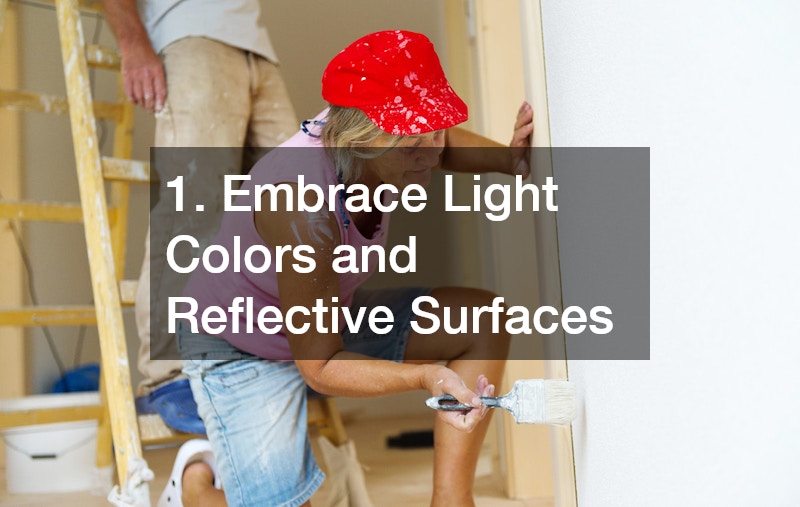Creating a home that feels spacious and welcoming is about more than just square footage. Thoughtful design, smart organization, and strategic renovations can transform even a smaller space into a light-filled, open environment. Open homes feel inviting, improve daily comfort, and often increase resale value.
From improving natural light to reorganizing furniture and updating finishes, there are numerous strategies to enhance a home’s sense of openness. This guide explores ten practical ways to make your home feel more airy, combining style, function, and comfort for every room.
Equally important is understanding how these changes interact with the overall layout and aesthetic. Even small adjustments can dramatically shift the perception of space, making rooms feel larger and more comfortable. By pairing professional services with strategic design choices, homeowners can achieve a bright, airy home that appeals to both residents and future buyers.
1. Embrace Light Colors and Reflective Surfaces

Color dramatically impacts how a space feels. Lighter shades on walls, ceilings, and floors make rooms appear larger and more open. Whites, soft pastels, and neutral tones bounce light around the space, reducing the sense of confinement. Even subtle differences in color temperature can change a room’s mood; for example, warmer neutrals create a cozy openness, while cooler shades feel crisp and expansive.
A painting company can provide professional guidance on color selection, finishes, and techniques to maximize light reflection. Experts can advise on wall treatments, ceiling colors, and trim options that complement existing décor while amplifying natural light. Using semi-gloss or satin finishes further enhances brightness without creating harsh glare.
Reflective surfaces such as mirrors, glass tables, or metallic accents also amplify the perception of space. Positioning mirrors across from windows or in narrow hallways extends the visual depth of a room. Even small reflective accents like metallic lamps or light-colored picture frames help bounce sunlight around, creating a subtle but powerful effect. By thoughtfully combining paint choices with reflective elements, you can instantly make your home feel brighter, more open, and welcoming.
2. Optimize Window Treatments
Windows are a primary source of natural light, and the way you treat them can dramatically affect how spacious a room feels. Heavy drapes or dark blinds restrict sunlight and create a closed-in feeling. Choosing light-colored, sheer fabrics allows natural light to flood the space while maintaining privacy. Minimalist window coverings can also highlight views and make the room feel connected to the outdoors.
Sliding window repair ensures that all windows operate smoothly, letting you open them fully to enhance airflow and bring in fresh air. Stiff, stuck, or damaged windows reduce the circulation of air, making rooms feel stagnant. Keeping windows in top condition ensures both light and ventilation contribute to an open atmosphere.
Proper window placement and furniture arrangement amplify light and openness. Avoid blocking sills with large furniture or décor items, and consider using reflective window hardware or light-colored frames to complement the airy effect. Adding plants near windows can also enhance the feeling of openness by drawing the eye upward and connecting indoor spaces with the outdoors. Thoughtful window treatment choices combined with functional repairs allow homeowners to maximize natural light, airflow, and overall room openness.
3. Declutter and Simplify Furniture Layout

Even large rooms can feel cramped if furniture is overcrowded or poorly arranged. Decluttering is one of the simplest yet most effective ways to make a home feel more spacious. Removing unnecessary items, consolidating décor, and strategically placing furniture improves visual flow and creates a sense of freedom within the space.
Choosing furniture proportional to the room size prevents visual overcrowding. Multipurpose pieces, like storage ottomans, sofa beds, or nesting tables, reduce clutter while maintaining functionality. Arranging furniture to create clear pathways allows easy movement and encourages the eye to travel across the room, enhancing the perception of openness.
Minimalism does not mean stripping personality from a room; instead, it emphasizes carefully curated items that serve a purpose or spark joy. Organized shelving, strategically placed accent pieces, and hidden storage solutions create both style and utility. These approaches prevent the room from feeling heavy or crowded. By decluttering and arranging furniture thoughtfully, homeowners can make even modest spaces feel airy, well-designed, and welcoming for both everyday life and entertaining guests.
4. Upgrade Lighting Fixtures
Lighting is critical for creating the illusion of space. Even rooms with ample natural light can benefit from layered artificial lighting to enhance brightness and depth. A combination of ambient, task, and accent lighting ensures even illumination, reduces shadows, and highlights architectural features. Properly lit rooms feel open, inviting, and functional.
Electricians can help install modern lighting systems, recessed lights, dimmers, or strategically positioned fixtures to enhance both brightness and efficiency. Highlighting specific areas, such as artwork, shelving, or seating nooks, draws the eye upward and creates depth. Task lighting in kitchens, offices, and bathrooms improves usability while reinforcing the sense of an open layout.
Energy-efficient LED lighting complements natural sunlight, providing bright illumination without excessive heat or glare. Combining layered lighting with reflective surfaces and light wall colors maximizes the perception of space. Well-planned lighting makes rooms feel expansive, comfortable, and intentional, supporting both design and daily living needs.
5. Incorporate Open Storage Solutions

Storage plays a critical role in maintaining a spacious feeling. Closed, bulky cabinets can crowd a room, making areas feel confined. Open shelving, floating cabinets, or glass-front units create vertical space and maintain visual accessibility.
Bathroom remodeling projects often use open shelving to maximize storage without overwhelming the room. Similarly, home remodeling may replace heavy cabinets with open alternatives in kitchens, living areas, or hallways. Displaying essentials and décor in an organized manner ensures spaces remain functional yet visually light.
Open storage encourages organization, keeps surfaces clear, and allows decorative items to shine. By combining floating shelves, modular storage, and functional displays, homeowners can maintain a balance of practicality and style. This approach also draws attention upward, making ceilings feel higher and rooms feel airier. When storage is both accessible and visually unobtrusive, the entire home benefits from a sense of openness and clarity.
6. Update Flooring and Carpets
Flooring continuity affects how expansive a home feels. Using uniform, light-colored flooring across multiple rooms visually connects spaces and creates a seamless flow. Dark or highly contrasting transitions can break continuity and make rooms feel smaller.
Carpet stores now offer low-pile, light-toned carpets that contribute to openness while maintaining comfort. Whether opting for hardwood, laminate, or carpeting, a consistent palette ensures visual cohesion. Additionally, polished surfaces reflect light, enhancing brightness and the perception of space.
Flooring materials also influence how open and airy a home feels to the touch. Smooth, uncluttered surfaces allow movement to flow naturally, reducing visual interruptions. Even small details, like matching thresholds or coordinating trims, reinforce the sense of spaciousness. Thoughtful flooring choices, paired with complementary wall colors and furniture arrangements, make a home feel larger, brighter, and more inviting.
7. Add or Expand a Sunroom

A sunroom addition is an impactful way to increase natural light and create a sense of openness. Sunrooms act as transitional spaces, connecting the indoors with the outdoors while providing functional living areas for relaxation, reading, or entertaining.
Large windows and glass walls allow sunlight to flood interior spaces, creating brightness and enhancing airflow. A well-designed sunroom not only increases usable square footage but also improves the perception of space in adjacent rooms. Incorporating light finishes, reflective surfaces, and minimal furnishings ensures the sunroom feels airy rather than crowded.
Sunrooms can also support multifunctional uses, such as home offices, indoor gardens, or casual dining areas. By strategically linking a sunroom addition to living spaces, homeowners achieve a cohesive, expansive feel throughout the home. This design approach amplifies openness, making the entire property feel lighter, brighter, and more welcoming.
8. Ensure Proper Ventilation and Clean Airflow
Air quality significantly influences how open a home feels. Stale or poorly ventilated spaces can feel heavy and closed-in, while fresh airflow creates a breathable, airy environment. Proper ventilation, combined with clean air systems, maximizes comfort and the perception of space.
Air duct cleaning removes dust, allergens, and debris, improving circulation and supporting healthy indoor air. Similarly, maintaining an HVAC system ensures balanced temperature and airflow throughout the home. Clean vents and ducts prevent stagnant areas, allowing rooms to feel fresh, light, and comfortable.
Good airflow also prevents moisture buildup and odors, which can make rooms feel smaller and less inviting. When paired with natural light and thoughtful design, proper ventilation ensures a home feels open, airy, and enjoyable year-round. Regular HVAC inspections, combined with air duct cleaning, protect both home systems and overall living quality.
9. Maximize Bathroom and Kitchen Space
Bathrooms and kitchens are among the most important spaces in a home when it comes to creating a sense of openness. Their layouts, materials, and organization significantly affect how spacious the rest of the house feels. Bathroom remodeling can transform cramped or outdated bathrooms into light, airy retreats. Removing unnecessary walls, installing clear glass shower doors, and choosing light-colored tiles or countertops can immediately make the room feel larger. A custom shower base adds a sleek, low-profile element that minimizes visual bulk and creates more usable floor space. Beyond appearance, thoughtful plumbing layouts and efficient storage solutions help maintain a clean, uncluttered environment that enhances the perception of space.
Kitchens, often considered the heart of the home, benefit greatly from organized layouts and strategic design choices. Decluttering countertops, installing open shelving, and using minimalist cabinetry prevents the space from feeling crowded, while keeping essentials within easy reach. Properly organizing appliances, integrating hidden storage solutions, and maintaining clear work surfaces allows for smooth workflow and keeps the visual lines open. Reflective surfaces, such as glossy backsplashes or polished countertops, amplify natural and artificial light, further enhancing the sense of airiness.
10. Maintain Systems for Efficiency and Comfort
Efficient, well-maintained systems are essential not only for comfort but also for enhancing a home’s overall sense of openness. A properly functioning HVAC system ensures consistent airflow and balanced temperature throughout each room, preventing stuffiness and creating a breathable environment that complements natural light and open layouts. When air circulates effectively, rooms feel larger and more inviting, and occupants experience greater comfort in daily living. Regular servicing of your HVAC system, including filter changes and duct inspections, keeps the system operating efficiently and reduces energy waste.
Electricians play a vital role in maintaining a home’s functionality while preserving its airy aesthetic. Updating outlets, wiring, and lighting fixtures can support modern appliances and devices without cluttering spaces with cords or bulky equipment. Properly positioned lighting enhances openness by reducing shadows and illuminating corners that may otherwise feel cramped. Thoughtful electrical planning also allows for the integration of energy-efficient lighting and smart home controls, which further contribute to a streamlined, spacious feel.
Plumbing maintenance is equally important, particularly during home remodeling projects. Reliable plumbing prevents leaks, water damage, or warped surfaces that can make rooms feel smaller and closed-in. Installing high-quality fixtures, efficient water lines, and well-placed drains ensures both functionality and visual harmony.
By keeping HVAC, electrical, and plumbing systems in top condition, homeowners create interiors that allow design features, furniture, and natural light to shine. Comfortable, well-serviced spaces not only feel more open and airy but also convey a sense of intentional, high-quality design that both residents and visitors can immediately appreciate.
Creating a home that feels open and airy combines professional services, strategic design choices, and thoughtful finishing touches. By embracing light colors, optimizing windows, decluttering, updating lighting, and maintaining systems, you can transform interiors into light-filled, welcoming spaces.
Investing in services like a painting company, bathroom remodeling, custom shower bases, sliding window repair, electricians, HVAC system maintenance, air duct cleaning, and flooring from carpet stores ensures quality, functionality, and style. Adding features such as a sunroom addition further enhances natural light and spatial flow, while organized storage and consistent décor maintain a cohesive, airy feel throughout the home.
By applying these ten strategies, homeowners can create spaces that feel expansive, comfortable, and visually appealing, making a lasting impression on both residents and visitors. A home that balances style, functionality, and openness not only improves day-to-day comfort but also strengthens market appeal, adding long-term value.

